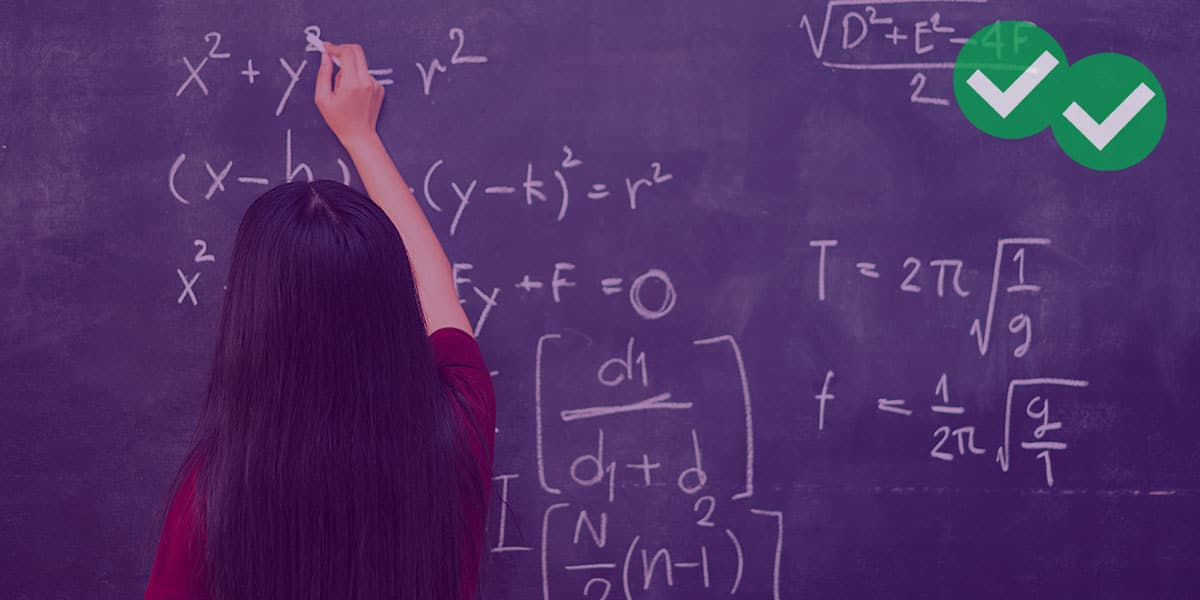The content in this post applies in 2025 to the new, shorter GRE!
Exponents have long been the bane of many students—and GRE exponents even more so. To do that, you’ll need a solid understanding of GRE arithmetic and plenty of practice with exponents.
In this post, we’ll take a look at GRE exponent basics (yes, that’s the stuff you learned—and, if you’re like most of us, probably forgot—back in high school). Then, we’ll do a whole lot of GRE exponent practice. Consider this your own private GRE tutoring session about powers! Let’s dive in.
Table of Contents
- GRE Exponent Rules and Basics
- GRE Exponent Lesson Videos
- GRE Exponent Practice Questions
- GRE Exponent Practice Answers and Explanations
We have practice questions for each question type. If you’re already familiar with exponent rules, use the links below to jump directly to a practice set:
- Adding/Subtracting Exponents
- Multiplying/Dividing Exponents
- Exponents Raised to Exponents
- Bonus Exponent Problemss
GRE Exponent Rules and Basics
Before any other exponent rules, you need to know about the base. You’ll see this in all GRE problems that involve powers. The base is the number underneath the exponent. In \(2^3\), two is the base and three is the exponent. \(2^3\) means that you are multiplying \(2,\) (the base) three times: \(2*2*2=8 \).
You’ll need to know about the base for every GRE problem involving powers. Other than that, it’s a matter of understanding which arithmetic rules to use in which scenario–after all, at the end of the day, powers are part of arithmetic, which is one of the core concept areas tested in GRE Quant!
Adding Powers
What happens when you are adding similar bases? Can you just add the powers? For example:
\(2^7+2^5\)
Can we add the \(7\) and the \(5\)? The answer is an unequivocal no. The only way you can change the above number is by factoring: \(2^7+2^5=2^5(2^2+1)= 2^5(5)\). This last step is relatively advanced, and I wouldn’t worry about it too much unless you are going for a high score. Just remember, if you are adding the bases—whether the same or different—then you cannot add the powers.
Takeaways about adding exponents:
- You cannot add exponents when adding bases
- It doesn’t make a difference whether bases are the same or different—you can’t add them!
- To solve problems that require adding exponents, you need to factor
Subtracting Powers
Everything I just said about adding powers? It’s also true for subtracting them. If you have a hard time remembering this, just keep in mind that subtracting is the same thing as adding a negative number.
To prove this, let’s take a look at a variation on the previous example.
\(2^7-2^5\)
The answer is NOT \(2^2 \)! Instead, what you need to do is factor: \(2^7-2^5=2^5(2^2-1)= 2^5(3)\)
Takeaways about subtracting exponents:
- You cannot subtract exponents when subtracting bases
- It doesn’t make a difference whether bases are the same or different—you can’t subtract them!
- To solve problems that require subtracting exponents, you need to factor
Multiplying Powers
\(2^5*2^3\)
The rule is as follows: if the bases are the same and you are multiplying them, add the powers. So \(2^5*2^3=2^8\). That is, I keep the base \(2\) the same (I don’t multiply it) and then I add the powers.
What about \(2^5*3^3\)? Well, the bases are different so we cannot combine them as we did before. Remember: you can only multiply exponential terms when the bases are the same. In this case, you would just have to multiply the long way, \(32*27=864\).
However (yup, just to make it a little more complicated!), there is one exception to this different base rule. If the exponents are the same but the base is different, you can multiply the bases. In \(2^5*3^5\), the bases are different but both are to the fifth power. In this case, we keep the power the same and we multiply the bases. Therefore, \(2^5*3^5=6^5\).
Takeaways about multiplying exponents:
- Add powers when multiplying terms with the same bases
- You can only multiply exponential terms with the same bases OR the same power
Dividing Powers
Just like adding and subtracting exponential terms, multiplying and dividing exponential terms go hand in hand–except that when you’re dividing, you subtract the powers. So \(2^5/2^3=2^2\). That is, I keep the base \(2\) the same (I don’t multiply it) and then I subtract the powers.
Similarly, if you’re looking at \(2^5/3^3\)? The bases are different—you guessed it, we cannot combine them as we did before. Remember: you can only divide exponential terms when the bases are the same. In this case, you would just have to divide the long way, \(32/27=1.185\).
BUT, when the bases are different and the powers are the same, you can divide the bases. In \(4^5/2^5\), the bases are different but both are to the fifth power. In this case, we keep the power the same and we divide the bases. Therefore, \(4^5/2^5=2^5\).
Takeaways about dividing exponents:
- Subtract powers when dividing terms with the same bases
- You can only divide exponential terms with the same bases OR the same power
Exponents with Exponents
So, I know you’re all wondering: what happens when you take an exponent to an exponent?
\((4^3)^2\)?
In this case, you multiply the powers while keeping the base, 4, the same.
\(3*2 = 6\).
Therefore, \((4^3)^2=4^6\) not \(4^9\).
Takeaways about raising an exponent to an exponent:
- Keep the base the same
- Multiply the powers
GRE Exponent Practice Questions
Think you got it? See if you can answer the following exponent practice questions correctly!
We’ve provided clickable radio buttons for you to select your answer as you go through these GRE exponent practice questions. This way, you can keep track of your answers and check your work at the end. However, please note that there’s no option to submit them!
Adding & Subtracting Exponents Practice
Question 1
Reduce \(3^8+3^7\) to its simplest form.
Question 2
\(4^3+4^3+4^3+4^3=\)
Question 3
If \(3^{-x}+3^{-x}+3^{-x}=1\), what is the value of \(x\)?
Multiplying & Dividing Exponents Practice
Question 1
Reduce \(5^4*3^4\) to its simplest form.
Question 2
If \((4^2)^3*2^6=2^y\), what is the value of y?
Question 3
\(3^{-n}*3^{-n} = 1/81\), what is the value of n?
Question 4
What is the sum of the digits of integer x, where x = \(4^10 x 5^13\)?
Question 5
\((5^{10}+5^{9}+5^{8})/5^{7}\)
Exponents Raised to Exponents Practice
Question 1
Reduce \((3^2*3^7)^2\) to its simplest form.
Check the answer here!
Question 2
\((2^5)^4+(2^3)^2=\)
Bonus Exponent Problems
Question 1
If \(0<10^n < 1,000,000\), where n is a non-negative integer, what is the greatest value of \(1/2 ^n\)?
Question 2
(5/4)-n < 16-1
What is the least integer value of n?
Check the answer here!
Question 3
The equation \(n < 1/{(-2)^{-n}} < 135.43\) is true for how many unique integer values of n, where n is a prime number?
Answers and Explanations
Now that you’ve had some GRE exponent practice, check your answers to see how you did!
Adding & Subtracting Exponents Answers and Explanations
Question 1
Answer: \(3^8+3^7\). Because you cannot mix bases, leave as is.
Question 2
Answer: C. Do not simply add the powers together. You can only do that when you are multiplying powers, not adding them. Instead, notice how there are 4 of the same number, \(4^3\). Therefore, \(4^3(1+1+1+1) = 4^3(4) = 4^4 = 256\).
Question 3
Answer: E.The best way to deal with this problem is by plugging in the answer choices. B, C, and D will all result in some funky irrational number because you are taking the square or cube root of the number. That leaves us with (A) -1 and (E) 1. Plugging in (A), you end up getting \(3^1+3^1+3^1=9\). Therefore, the answer has to be (E) 1. Remember, also, that any number taken to a negative exponent results in the reciprocal of that number, e.g. \(3^{-1}=1/3\). And \(1/3+1/3+1/3=1\).
Multiplying & Dividing Exponents Answers and Explanations
Question 1
Answer: \(15^4\). Multiply the bases and leave the powers alone; \( 5 x 3 = 15\).
Question 4
Answer: B. Notice that \(4^10\) can be rewritten as \(2^20\). We can now express \(x\) as \(2^20 x 5^13\). The logic here is that \(2 x 5 = 10\). That is, 10 to any integer power greater than 1, will be a 1 followed by zeroes.
So now, let’s rewrite the problem again so we get \(2^7 x 2^13 x 5^13\). Combine \(2^13 x 5^13\) and we get \(10^13\). That is, we get 1 followed by 13 zeroes. If you are taking the sum, it’s straightforward: 1 plus 13 zeroes is 1. We are not done yet as we have the \(2^7\). When you multiply this out, you get 128. 128 x 1,000 thirteen zeroes is equal to 128 followed by the thirteen zeroes. Ignore the zeroes and we get \(1 + 2 + 8\), which equals 11.
Exponents Raised to Exponents Answers and Explanations
Question 1
Answer: \(3^18\). First, add the powers inside the parenthetical to get \((3^9)^2\). Then, combine both powers by multiplying.
Go back up to Question 1.
Question 2
Answer: D First, you must multiply the power in parentheses to the power outside the parentheses, giving you: \(2^20+2^6\). Remember, that does not add up to \(2^26\). If you factor \(2^6\) from both \(2^20\) and \(2^6\), you get: \(2^6*(2^14+1)\). Also, you can use approximation and eliminate those answers that are too small and too big. Answer choice E is far too big, and Answer choice A too small.
Bonus Exponent Problems Answers and Explanations
Question 1
Answer: B. Don’t think big – think small. That is the smaller n becomes the greater ½^n becomes. So what is the smallest value? You may be tempted to say 1, which would give us ½. But remember n = 0, because \(10^0 = 1\). Therefore \(1/2^0 = 1\) The “hidden zero,” as I like to call it, is a classic GRE math trick. So always keep your eyes open, especially when you see “non-negative integer,” which includes zero.
Go back up to Question 1.
Question 2
Answer: 13. The best place to start here is by getting rid of the unseemly negative signs and translating the equation as follows:
(4/5)n < 1/16
A good little trick to learn using 4/5 taken to some power is that (4/5)3 = 64/125, which is slightly — but only slightly — greater than ½. Therefore, we can translate (4/5)3 to ½.
(1/2)4 = 1/16
That would make (4/5)12 a tad larger than 1/16. To make it less than 1/16 we would multiply by the final 4/5, giving us n = 13.
Go back up to Question 2.
Question 3
Answer: D. The most important piece of info is n is a prime number. So do not start by plugging in zero or one. Neither is a prime. The lowest prime is 2. When we plug in ‘2’ we get:
\(2 < 1/{(-2)^{-2}} < 135.43\)
\(2 < 4 < 135.43\)
This is clearly true. Thus we have one instance.
As soon as we plug in other prime numbers a pattern emerges.
\(1/{(-2)^{-n}}\) is always a negative number if n is odd. Because all of the primes greater than 2 are odd, the number in the middle will always be negative:
\(1/{(-2)^{-3}}=-8\)
\(1/{(-2)^{-5}}=-32\)
Because in each case n is a positive number we can never have the middle of the dual inequality be positive, if n is an odd prime.
Thus the only instance in which the inequality holds true is if we plug in ‘2’, the answer is (C).
Lastly, for more GRE math practice (for exponents as well as other topics), try this full-length, free practice test from Magoosh that includes a detailed score report with a topic-by-topic breakdown of your performance. You can choose to do just the Quant section or a full length exam. Happy studying!





